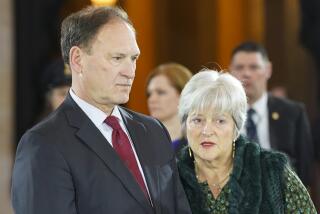Flirting with justice
After his first argument before Justice Sandra Day OâConnor, one prominent Southern lawyer was certain the Supreme Court would rule in his favor â because, he said, she was âflirtingâ with him. The comment speaks volumes about the speaker, but it also says something about the person who weaved her way through a male-dominated world to become the first female justice 30 years ago today, and served 25 years on the court.
OâConnor wasnât chosen because she looked the part, but the fact that her pearls and lavender suits with skirts wouldnât alarm the public wasnât inconsequential. âIt was simply a matter of political reality that ⌠a woman had to appear and act âfeminine,ââ she has said. âPeople gave up their traditional notions only grudgingly.â
She worked as a lawyer first at a county district attorneyâs office, having been offered only a legal secretaryâs job at private firms despite graduating near the top of her class at Stanford Law School. She followed her husband overseas when he finished school. She had her first child three days after being sworn in to the Arizona bar and then, because private Arizona law firms were no more hospitable to women than California ones, she opened her own firm.
She spent five years on the âmommy trackâ when she lost her sitter and couldnât work child-care miracles, using the time to get more involved in politics and the Junior League. She has said it never occurred to her or her husband that he might stay home while she worked.
Four years after OâConnor returned to work, she was appointed â by a Republican â to fill an Arizona state Senate seat, eventually becoming the first female majority leader in a state senate. She was serving on the Arizona Court of Appeals â as a Democratic appointee â when the Reagan administration sent Ken Starr to interview her for the Supreme Court. She served Starr a salmon mousse salad sheâd prepared for the occasion.
Iâd just begun my first year of law school as a summer starter at the University of Michigan when OâConnor was nominated in 1981. Iâd grown up being excluded from Little League and shop, cooking biscuits in home-ec (which had nothing to do with economics) with no real idea things might be different. Itâs a hard thing to see as wrong something thatâs always been the case. Even when I graduated from law school in 1984, no American woman had run an Olympic marathon or become surgeon general or attorney general or poet laureate.
But I was sure OâConnorâs appointment was the first major drop in what would become a bucketful of women stepping into leadership roles. Never mind the letters she received saying things like âBack to your kitchen and home female! This is a job for a man and only he can make the rough decisions.â The world had changed.
That was a generation ago. It surprises me in retrospect that I didnât weep with joy when OâConnor was sworn in. It was something that ought to happen and so of course it had. I was a lot younger then and considerably more naive. No professor had taught me what to say to clients remarking on my breasts or asking me to fetch coffee. I hadnât realized how important membership in menâs clubs I could not join was to generating legal business, or even that generating business was more important to advancement than lawyerly skills. Iâd failed to realize what a powerful marketing tool a low golf handicap is, or that a husband who does laundry is as necessary as he is rare.
I did weep when Ruth Bader Ginsburg was sworn in as the second female justice a dozen years later, and Nancy Pelosi as speaker of the House 15 years after that. The subsequent rounds of barrier breaking have taken a long time.
The pipeline is slow and leaky, to be sure, but progress is being made. At the time of OâConnorâs appointment, only three women had ever served full Senate terms; now we have 17 female senators. Only one woman had ever been chief executive of a Fortune 500 company; there are currently 11. When Ronald Reagan took office, 48 of 700 federal judges were women, up from 10 just four years earlier; now women make up 26% of state and 22% of federal judges, and a third of the Supreme Court. Role models matter. Opportunities matter.
And changes in the law matter.
OâConnorâs first major Supreme Court opinion, in Mississippi University for Women vs. Hogan, began the process of changing the law of gender discrimination, allowing a man admission to a womenâs nursing college because to do otherwise âlends credibility to the old view that women, not men, should become nurses.â She was the swing vote in Price Waterhouse vs. Hopkins, finding discrimination had been âa substantial factorâ in a decision not to promote a woman to partnership, and in Jackson vs. Birmingham Board of Education, allowing a whistle-blower to sue for retaliation in gender-discrimination circumstances. Her vote in Davis vs. Monroe allowed a girl whoâd been subjected to relentless sexual taunts by a classmate to sue the school for allowing a hostile environment to go unchecked.
The truth is that wise men and wise women do sometimes reach different conclusions: Jennifer L. Peresie, writing in the Yale Law Journal, found that women claiming sexual harassment or gender discrimination were twice as likely to prevail when a female judge was included on the bench, an effect independent of judicial ideology.
Despite OâConnorâs record on gender rights, though, she by no means always pleased womenâs rights advocates, much less liberals as a whole. Her swing votes allowed substantial limitations on abortion rights, affirmative action and gun control, and her vote in Bush vs. Gore gave George W. Bush the presidency. She disappointed conservatives too, and not only with respect to gender discrimination. She limited school prayer, expanded gay rights and allowed campaign finance reform. OâConnor was a woman who voted her conscience.
Women in prominent roles matter for what they achieve substantively, that different wisdom Peresie found. They serve as models for younger women trying to succeed in a world that still struggles with gender issues. And seeing other women achieve allows us to believe that we too might be talented and, armed with that belief, to push through the obstacles and reach for our dreams.
In nudging the Supreme Court doors open, OâConnor made way for Justices Ginsburg, Sonia Sotomayor and Elena Kagan, and even for the possibility of nine wise women, and one woman who will finally be considered wise enough to be elected president. In her holdings themselves, and in her holding against expectation to her own sense of the law, Sandra Day OâConnor demonstrated that the time to give up traditional notions of gender roles had come. This one wise judge set everyone on notice that women were no longer merely to be flirted with, if we ever were.
Meg Waite Clayton is the author of three novels, most recently âThe Four Ms. Bradwells.â She practiced merger and acquisition law at an L.A. firm.
More to Read
A cure for the common opinion
Get thought-provoking perspectives with our weekly newsletter.
You may occasionally receive promotional content from the Los Angeles Times.










